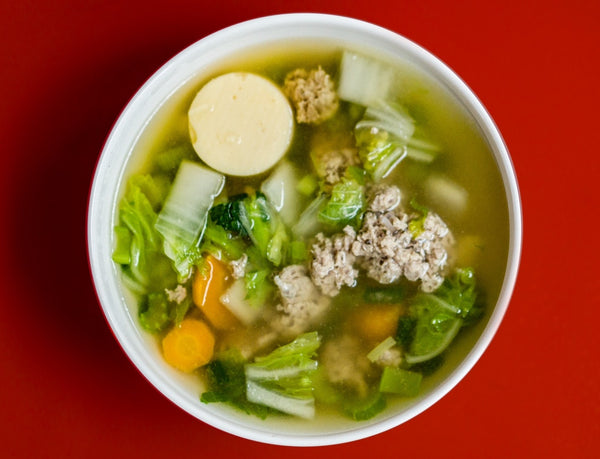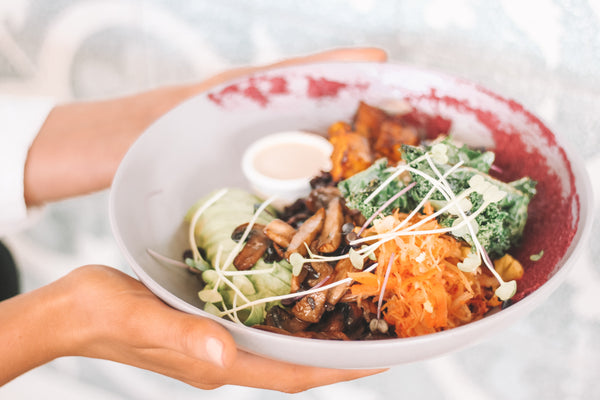There are a lot of ways to bring health and wellness into your life. You can enroll in a gym, take up a sport, start a meditation practice, or eat well. We like the latter for its three-pronged benefits — not only is a healthier diet a relatively easy switch and not too far from your regular fare (Healthy pancakes? All-natural chips? These are things that exist), its effects go way beyond the physical.
The keto diet, for instance, can help improve brain function and heart health. Going paleo can help lower blood sugar levels, reduce chronic inflammation, and improve insulin sensitivity. An extension of the popular paleo diet is the autoimmune protocol (also known as paleo autoimmune protocol, autoimmune paleo diet, or AIP).
Unlike paleo, which is often referred to as “the caveman diet” for its prehistoric roots, AIP is relatively new. The earliest mentions of it were in 2011, mainly by paleo advocates Dr. Loren Cordain, Robb Wolf, and Dr. Sarah Ballantyne.
At that time, Dr. Cordain noted that a lot of the food consumed on the paleo diet, namely eggs, nuts, seeds, and nightshade vegetables‚ would trigger the symptoms of those with autoimmune diseases. So together with other early adopters, he began testing out a new science-based diet — one that provided the benefits of paleo without aggravating the symptoms of autoimmune diseases.
This was the beginning of the AIP diet. Since then, it has grown into a massive movement with hundreds of AIP books, coaches, and devoted practitioners.
What Is an Autoimmune Disease?
The AIP diet was designed to reduce inflammation within the body and relieve the symptoms of autoimmune diseases. To understand why this is so important, it helps to know exactly what an autoimmune disease is.
An autoimmune disease arises when, instead of protecting against disease and infection, an individual’s immune system starts attacking healthy cells by mistake. The body is no longer able to tell the difference between its own cells and foreign cells, resulting in a system breakdown that causes chronic inflammation and tissue destruction.
These diseases manifest themselves in a number of ways — rheumatoid arthritis, inflammatory bowel disease, type 1 diabetes, multiple sclerosis, and more — with the main differentiator being which part of the body (or which type of tissue) is being targeted by the immune system.
Some diseases pinpoint a particular organ. For example, rheumatoid arthritis arises when one’s immune system starts to attack the joints, while multiple sclerosis is an assault on the myelin sheath surrounding the body’s nerves. Other diseases, such as systemic lupus or systemic sclerosis, affect the whole body.
There are currently more than 100 types of autoimmune disorders and diseases, all of which have no proven cause or cure. The symptoms flare up when triggered, and alleviate when the body’s inflammation is properly addressed.
The quick cure is usually prescribing some form of immune-suppressing, anti-inflammatory medication — if the immune system is attacking the body, it should be shut down, right? This, however, is a short-sighted solution. Not only does it merely suppress the disease, it also shuts down the entire immune system and leaves the body open to all other illnesses and infections.
Rather than pull the plug on one of the body’s most vital systems, research suggests that the answer lies in our own bodies — specifically, our gut. About 80% of our immune system lies in the lining of our gut. Due to a combination of modern factors, such as unhealthy diets, prolonged stress, and long-term NSAID (nonsteroidal anti-inflammatory drug) use, the gut lining can start to wear thin. This leads to chronic inflammation and internal tissue damage, and can cause autoimmune disease symptoms to flare up.
What Is the AIP Diet?

The AIP diet attempts to help those with these autoimmune conditions. With inflammation being a huge factor, not just in autoimmune conditions but in all chronic illnesses, regulating our food intake is one way we can make a big difference in our health.
With this in mind, AIP provides a food-based approach, focusing on four key goals — to restore the immune system, regulate hormones, improve gut health (and treat a leaky gut), and rebuild the body with vitamin-rich, nutrient-dense food.
The AIP works as an elimination and reintroduction diet, cutting out foods that are likely to be undermining one’s health and leaving foods that offer the most benefits. For a period of at least 30 days, all inflammatory food, gut irritants, and immune stimulants are eliminated from the diet.
So in addition to removing dairy, grains, legumes, and soy (as is done in the paleo diet), the AIP diet also takes away nuts, seeds, eggs, and nightshade vegetables (all highly inflammatory ingredients). This makes the AIP diet considerably more restrictive and more difficult to maintain.
AIP Diet Guidelines
As you may have guessed, the AIP diet is a very strict one with a long list of foods to avoid and a short list of foods to consume. In fact, there are several groups of restriction. The first group includes the foods you should avoid permanently (the ones also eliminated in paleo):
- Processed food
- Grains (rice, quinoa, barley, etc.)
- Dried legumes (beans, lentils, and nuts)
- Potatoes
- Soy
- Corn
- Dairy
- Refined vegetable oils and trans fat
- Refined sugars and artificial sweeteners
- Alcohol with fermented grains and coloring
For those starting the AIP diet, the following should also be eliminated:
- Eggs
- Nuts and seeds
- Fresh legumes (peas and green beans)
- Nightshade vegetables
- Nightshade spices
- Seed-based spices
- Seed oils (vegetable and canola oil)
- Dried fruit
- Chocolate
- Non-nutritive sweeteners (stevia, xylitol, mannitol)
- Gum
- Coffee
- Alcohol (even wine and clear distilled liquor)
In addition to the food above, it’s also best to avoid the following products:
- Fructose in excess of 20 grams a day
- Any potential gluten cross-reactive food (yeast, whey, millet, etc.)
- Emulsifiers, thickeners, and other food additives
- NSAIDs (ibuprofen and aspirin)
After all this elimination, you may be wondering what it is you can eat. The AIP diet is actually generous in meat, seafood, and leafy green vegetables. These can be paired with root crops and anything coconut, and washed down with a cup or two of green or black tea. The following is a list of all AIP-approved food:
- Vegetables, all except for nightshade vegetables (8 servings a day)
- Offal and organ meats (5 times a week)
- Beef bone broth and gelatin (from grass-fed beef)
- Fish and shellfish (at least 3 times a week)
- Meat and poultry
- Root crops (sweet potatoes, yams, cassava, etc.)
- Coconut products (coconut milk, coconut oil, coconut yogurt)
- Dairy-free fermented foods (kombucha, sauerkraut, water, kefir, etc.)
- Fruits (limit fructose to 20 grams a day)
- Onions, garlic, and other high-FODMAP foods
- Honey, molasses, or maple syrup (in limited quantities)
- Carob
- Salt (only unrefined salt, like Himalayan pink sea salt or Celtic gray salt)
- Vinegars (balsamic, red wine, apple cider, etc.)
- Herbs (fresh and non-seed)
- Arrowroot starch
- Rooibos, green, and black tea
With these as your basic ingredients, the AIP diet calls for a little creativity in the kitchen. Luckily, there are a lot of AIP-friendly, free recipes online. Even if you have to work with egg-free, grain-free ingredients, there are some amazing AIP breakfast recipes out there, including Smoky Maple Sage Breakfast Sausage, Green Plantain AIP Pancakes, and Apple Cauliflower Porridge.
As for lunch as dinner, how about some Balsamic Bacon Radicchio? Or Orange-Glazed Pork Tenderloin? Thanks to the food-loving AIP community, there are more than enough dishes to last you the entire 30 day elimination phase (that’s 90 square meals!).
How to Reintroduce Eliminated Food Into Your Diet

While 30 days is the minimum recommended time to stay in the elimination phase (and a magic number for most wellness regimens), some may opt to extend this to 90 days or even a whole year. The choice is completely up to you.
But an elimination diet isn’t meant to last forever, and it’s rare that someone is intolerant to everything on the list. As long as you wait long enough to experience clear improvements in your autoimmune symptoms, you can start to reintroduce certain foods whenever you feel it’s time.
Reintroducing food is best done slowly and in isolation — don’t add different food all at once. After adding a particular food back into your diet, wait a few days to observe any reactions.
It’s a good idea to document any changes through a food journal or even lab tests. Keep note of any sleep disturbances, headaches, skin rashes, digestive pains, mood swings, etc.
The process of reintroducing food follows the following four phases, moving from most nutrient-dense to least nutrient-dense. The individual can choose which of the foods they’d like to add back in each phase, making sure to do so one at a time.
Phase 1: Egg yolks, soaked and sprouted grains, soaked and sprouted legumes, seed-based spices, seed-based oils, grass-fed ghee, cocoa and chocolate, coffee (on an occasional basis)
Phase 2: Egg whites, nuts, seeds, grass-fed butter, coffee (on a daily basis), alcohol (in small quantities)
Phase 3: Eggplants, bell peppers, peas and lentils, grass-fed dairy, fermented dairy (kefir, yogurt, other probiotics)
Phase 4: All nightshade vegetables, nightshade spices, white rice, all gluten-free grains, all legumes, alcohol (in larger quantities)
Some may find they can consume most foods, with only a few ingredients that cause flare ups. Others may opt to simply never add them to their diets again.
No matter which foods you end up adding back to your diet (or not adding back, for that matter), it’s important to consume a variety of food and nutrients. Finding the best diet for your own body is the ultimate, long-term goal.
AIP Diet Benefits
If someone’s going to follow a diet as strict as the AIP, there are definitely a few benefits they can look out for — the main one being improved gut health.
The AIP diet is meant to be a healing diet, and by cutting out all the possible sources of inflammation, your gut is allowed to heal itself and restore the body’s digestive integrity. Followers of the diet have experienced a decrease in autoimmune symptoms, including a decrease in bloating, brain fog, and chronic pain.
In addition, the foods allowed on the diet are rich in vitamins and nutrients — grass-fed beef, leafy green vegetables, and healing herbs. Just consuming these for a month will already do wonders for your health.
By eating simply and introducing foods back into your diet slowly, you’ll be able to identify what works and doesn’t work well for your body, and you’ll learn more about your own health in general.
AIP Diet Drawbacks
The main drawback to following the AIP isn’t the diet itself, it’s what it takes to follow the diet. AIP’s fine-tuned food list is especially restrictive (even compared to other restrictive diets) and takes a lot of commitment. At the moment, food establishments don’t offer AIP-compliant meals, and it’s nearly impossible to identify all the ingredients in dishes you don’t make yourself.
So if you’re set on attempting the AIP diet, be prepared to do some extremely disciplined grocery shopping, read up on your AIP recipes, and prepare your own meals — at least for the first few months.
Who Should Go on the AIP Diet

As you can tell from the name, the AIP diet offers the most benefits for those who suffer from autoimmune diseases. If you’ve been diagnosed with one — celiac disease, Addison’s disease, Crohn’s disease, psoriasis, Hashimoto’s thyroiditis, lupus, and the like — then it’s definitely worth giving this diet a try.
AIP focuses on simple, nutrient-dense food that meets all your body’s needs without any additions that may cause inflammation. Even if you end up reintroducing most of the food back into your diet, going through a round of AIP can help you reset your immune system and identify exactly what triggers your symptoms to flare up. It’s an aggressive diet intended to produce aggressive results.
But you don’t have to have an autoimmune disease to reap AIP’s benefits. It’s a clean and simple way of eating that’s great for anyone who wants to detox and give their digestive system a break.
In this case, the AIP protocol doesn’t need to be as strictly followed. For instance, if you know you experience brain fog after eating a bowl of grains or significant bloating after consuming dairy, then simply remove the items you experience food sensitivities with from your daily diet.
How to Get Started on the AIP Diet
It’s common to chunk the AIP diet with all the other trendier eating plans. But it’s far from them. Although similar to paleo, AIP positions itself as a way of living with a focus on a stronger immune system and improved health.
As a science-based lifestyle backed by a lot of literature, the best way to start is with some required reading. Some good online resources include Autoimmune Wellness, The Paleo Mom, and Unbound Wellness. The articles and recipes on these sites will give you a taste of what being on the AIP diet is like.
All-natural meats, wild caught seafood, specialty herbs — these things can add up to a pricey grocery shopping list. There are, however, a few ways to keep costs down. Try more affordable cuts of meat (these are usually tougher and may require more cooking time), frozen products, and bulk portions of dried herbs and spices. As for produce, it’s always best to buy what’s in season. Not only will these items be more abundant and affordable, they’re usually much fresher.
The tendency when starting a new diet is to meal plan first and then go to the grocery store with a specific list in hand. This is a very pricey way to shop. Once you get the hang of how to prepare your favorite AIP dishes, start shopping without your set meals in mind. Look for more affordable items first, then plan dishes around them. There are sale items in every market, and being able to take advantage of these will significantly lower your food costs.
Lastly, some diets can afford a little cheat meal here and there. AIP is not one of them. The intention is to clear the body of all unwanted inflammation, and sneaking in a pack of cookies or chips is not the way to do it. The body will respond to inflammatory food, even if no one's watching.
Stick to the diet, no matter how hard it may be, and once you start feeling its benefits, the temptations will seem much less worth it.
The ABCs of the AIP
As far as diets go, the AIP is definitely not the easiest one. It takes a lot of commitment, planning, and mental preparation. But if you suffer from an autoimmune disease or are prone to inflammation, it’s one of the most highly recommended, all-natural methods to alleviate symptoms and improve your overall health.

